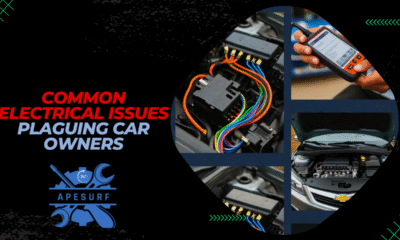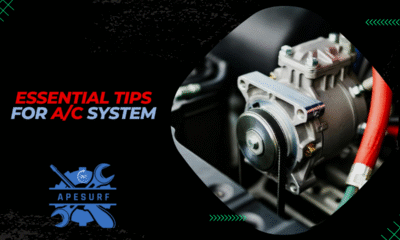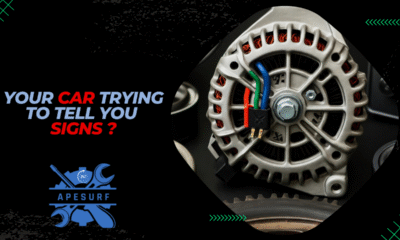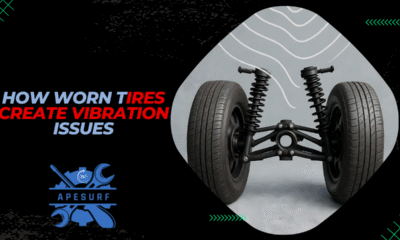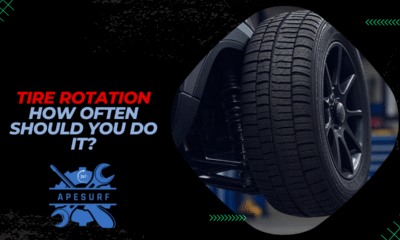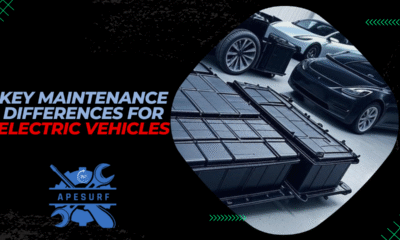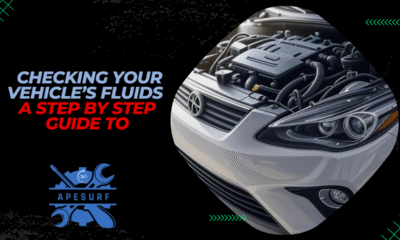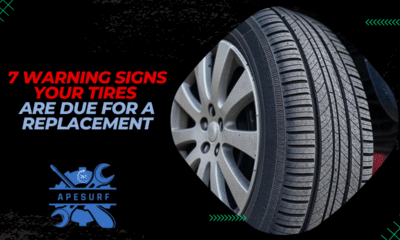Vehicle Maintenance
The Science Behind the Gas Coming out of Your Car’s Tailpipe
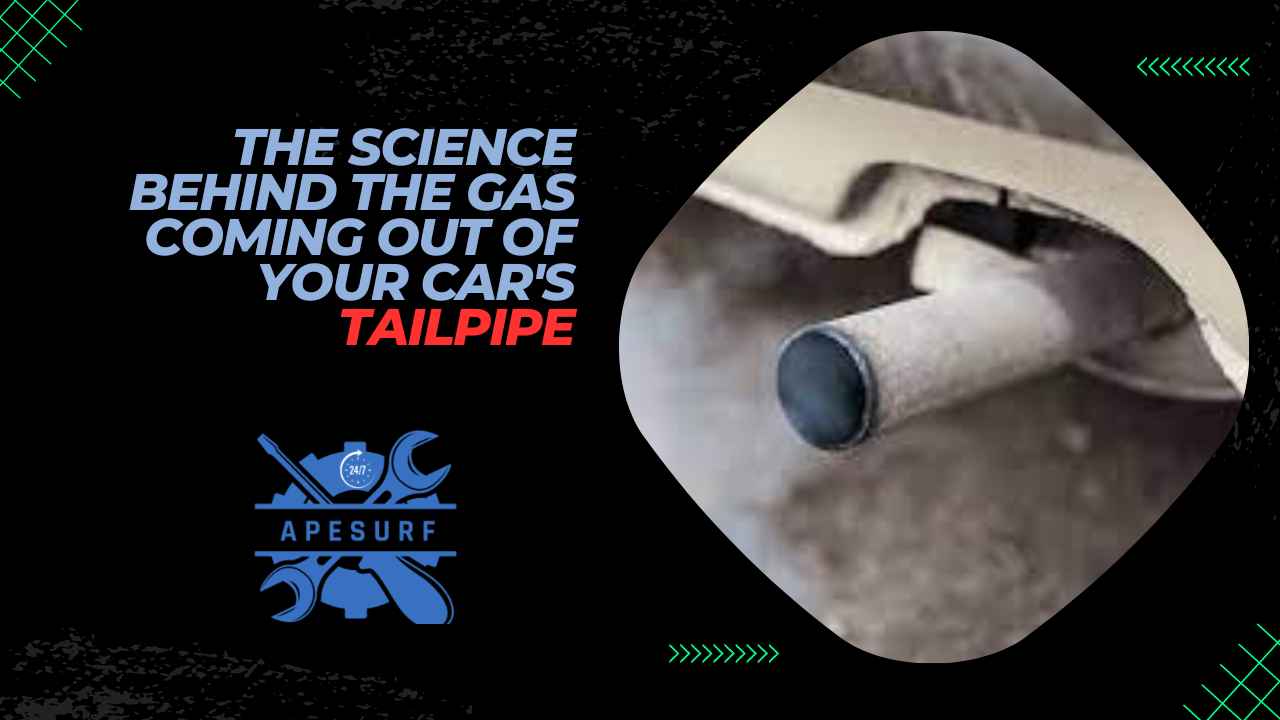
In this article, we will delve into the science behind the gas that comes out of your car’s tailpipe. We will explore what causes these emissions, the different types of gases released, and their impact on the environment. By understanding the science behind the gases emitted by our cars, we can make more informed decisions about vehicle maintenance and environmental protection.
What causes gas to come out of a car’s tailpipe?
When your car’s engine burns fuel, it produces a mixture of gases as byproducts. This gas is expelled through the exhaust system and ultimately exits through the tailpipe. The combustion process in the engine creates heat and pressure that convert gasoline into energy, releasing gases like carbon dioxide, carbon monoxide, nitrogen oxides, and hydrocarbons.
These gases are a natural result of the combustion process and are emitted in varying amounts depending on factors like the type of fuel used, engine efficiency, and driving conditions.
What are the different types of gases released from a car’s tailpipe?
Carbon dioxide (CO2) is one of the most common gases emitted by vehicles. It is a greenhouse gas that contributes to global warming and climate change. Carbon monoxide (CO) is another gas produced during combustion and is harmful to human health, as it can deprive the body of oxygen. Nitrogen oxides (NOx) are a group of gases that can cause respiratory issues and contribute to smog formation.
Hydrocarbons, another type of gas, are unburned fuel particles that can react with sunlight to form smog and ground-level ozone. These gases, when combined with other pollutants in the atmosphere, can have detrimental effects on air quality and human health.
How do these gases impact the environment?
The gases released from a car’s tailpipe have significant environmental implications. Carbon dioxide is a major contributor to climate change, as it traps heat in the Earth’s atmosphere and warms the planet. Nitrogen oxides and hydrocarbons can react in the atmosphere to form smog, which can be harmful to human health and vegetation. Carbon monoxide can also have negative effects on air quality and contribute to respiratory problems.
Overall, the emissions from vehicles play a significant role in air pollution and environmental degradation. It is essential to understand the impact of these gases and take steps to reduce emissions to protect our planet’s health.
How can we reduce the gas emissions from our car’s tailpipe?
There are several ways to reduce the gas emissions from your car’s tailpipe. Regular maintenance, such as tuning up your engine, changing the air filter, and ensuring proper tire inflation, can improve fuel efficiency and reduce emissions. Driving habits, such as avoiding rapid acceleration and excessive idling, can also help decrease gas emissions.
Using cleaner fuels, like ethanol or biodiesel, can lower the carbon footprint of your vehicle. Investing in hybrid or electric cars is another way to reduce gas emissions and reliance on fossil fuels. By taking these steps, we can lessen the environmental impact of our vehicles and contribute to a cleaner, healthier planet.
Conclusion
Understanding the science behind the gas emissions from your car’s tailpipe is essential for making informed decisions about vehicle maintenance and environmental protection. By knowing what gases are being released, their impact on the environment, and how to reduce emissions, we can take steps to minimize our carbon footprint and contribute to a cleaner, healthier planet.
FAQs
1. Why is carbon dioxide emitted from a car’s tailpipe?
Carbon dioxide is a byproduct of the combustion process in a car’s engine. It is released when gasoline is burned to produce energy for the vehicle. While carbon dioxide is a natural gas, excessive emissions from vehicles contribute to climate change and global warming.
2. How do nitrogen oxides impact air quality?
Nitrogen oxides are a group of gases that can cause respiratory issues and contribute to smog formation. When released into the atmosphere, they react with sunlight and other pollutants to form harmful ozone. This can lead to poor air quality, visibility issues, and health problems for humans and plants.
3. What are some ways to reduce gas emissions from a car’s tailpipe?
Regular maintenance, such as tuning up your engine and changing the air filter, can improve fuel efficiency and reduce gas emissions. Driving habits, like avoiding rapid acceleration and idling, can also help decrease emissions. Using cleaner fuels and investing in hybrid or electric vehicles are additional ways to reduce your carbon footprint.
4. How does carbon monoxide affect human health?
Carbon monoxide is a colorless, odorless gas that can be harmful to human health. When inhaled, it can bind to hemoglobin in the blood, reducing the body’s ability to transport oxygen. This can lead to symptoms like headaches, dizziness, and fatigue, and in severe cases, carbon monoxide poisoning.
5. What role do vehicles play in air pollution?
Vehicles are a significant source of air pollution, emitting gases like carbon dioxide, carbon monoxide, nitrogen oxides, and hydrocarbons. These pollutants contribute to smog, ozone formation, and poor air quality, which can have adverse effects on human health and the environment.
Vehicle Maintenance
Common Electrical Issues Plaguing car Owners
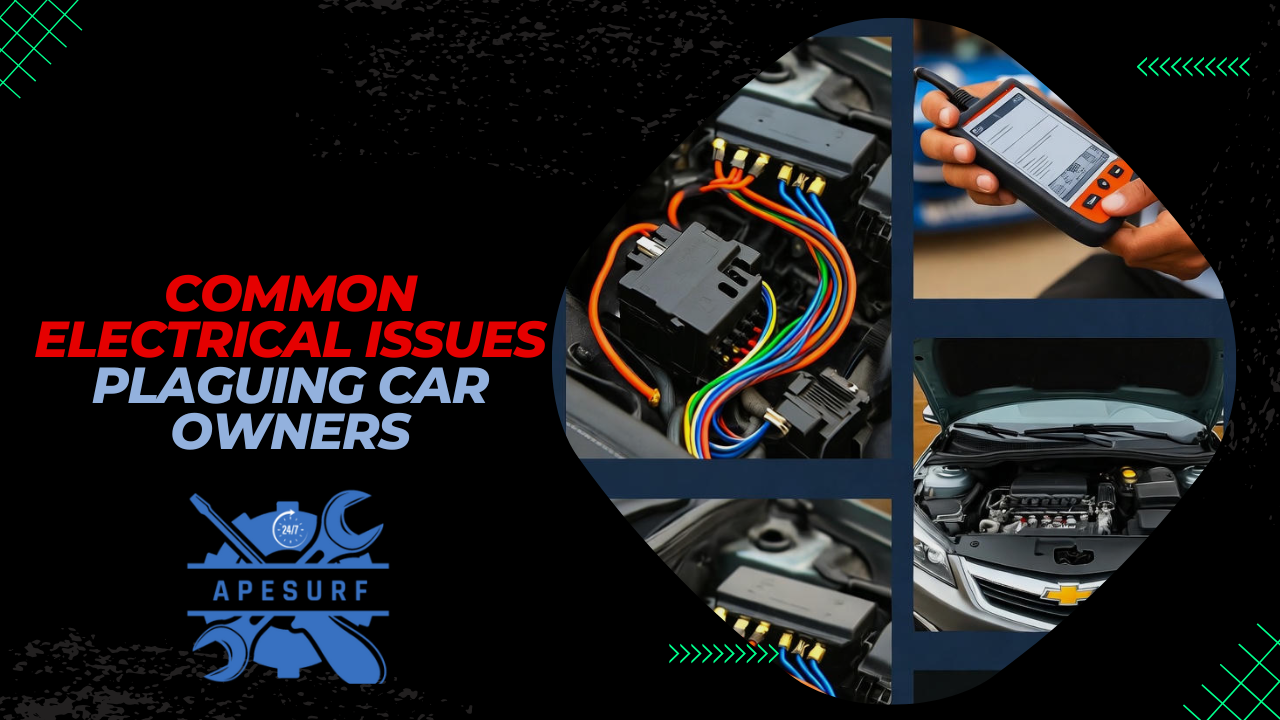
When it comes to cars, electrical problems often leave owners scratching their heads. The Chevy Malibu, a popular midsize sedan known for its comfort and fuel efficiency, is not exempt from these challenges. Understanding the nuances of Chevy Malibu electrical problems can save you time, money, and frustration.
What Are Chevy Malibu Electrical Problems?
Electrical problems in a Chevy Malibu refer to any malfunction or failure in the vehicle’s electrical system. This might include issues with the battery, alternator, wiring, computer systems, or electrical components like lights, windows, and infotainment systems. Problems can manifest through symptoms such as flickering lights, unresponsive buttons, or a failing battery.
Why Understanding Electrical Problems Is Important | Common Electrical Issues Plaguing car Owners
Understanding electrical issues in your Chevy Malibu is crucial for several reasons. First, these problems can range from minor annoyances, such as a malfunctioning radio, to major issues that can jeopardize your safety, like failing brake lights.
By recognizing signs early, you can prevent further damage and increase the lifespan of your vehicle. Additionally, awareness can afford you better negotiation power at auto shops, allowing you to address issues without falling victim to up-sell tactics that mechanics might use.
Benefits of Addressing Electrical Problems Promptly
Addressing Chevy Malibu electrical problems promptly offers numerous benefits.
Safety and Reliability
A vehicle that functions properly is crucial for safe driving. Electrical problems can lead to critical safety failures. For instance, a malfunctioning anti-lock braking system (ABS) can affect your braking capabilities. By addressing issues quickly, you ensure a safer driving experience for both you and your passengers.
Cost-Effectiveness
Ignoring small electrical problems can lead to bigger, more expensive repairs down the line. A failing battery, if not replaced promptly, can drain your alternator, requiring further repairs. By catching issues early, you can save money and avoid unexpected expenses.
Improved Performance
When electrical systems are functioning as intended, your car runs more smoothly. Issues like poor battery connections can cause irregular performance, leading to stalling or engine trouble. Fixing these issues ensures that your Chevy Malibu performs at its best.
Step-by-Step Guide: How to Diagnose Chevy Malibu Electrical Problems
Diagnosing electrical problems in your Chevy Malibu can be a daunting task, but following a systematic approach can simplify the process.
Step 1: Initial Inspection
Begin with a visual inspection of your vehicle. Check for any obvious signs of trouble such as frayed wires, corroded battery terminals, or burnt-out fuses. Sometimes, the solution can be as simple as tightening loose connections.
Step 2: Use an OBD-II Scanner
Modern vehicles, including the Chevy Malibu, come equipped with on-board diagnostics systems. Using an OBD-II scanner, you can read trouble codes that pinpoint specific electrical issues. These codes provide valuable insights into which systems are malfunctioning.
Step 3: Check the Battery
A failing battery is often the culprit behind most electrical problems. Test your battery’s voltage with a multimeter ideally, it should be around 12.6 volts when the engine is off. If the voltage is low, you may need a replacement.
Step 4: Inspect the Alternator
The alternator is responsible for charging the battery while your car is running. If you’re experiencing electrical issues, inspect the alternator for signs of wear or malfunction. A failing alternator may not recharge the battery adequately, leading to further electrical problems.
Step 5: Examine Fuses and Relays
Fuses and relays are crucial in protecting your vehicle’s electrical systems. If a specific system isn’t working, check related fuses. If a fuse is blown, replace it and see if the problem persists.
Step 6: Consult a Professional Mechanic
If you’ve gone through these steps and still experience electrical issues, it may be time to consult a professional. Electrical problems can be complex and require sophisticated testing equipment that most DIYers may not have access to.
Tips for Preventing Electrical Problems in Your Chevy Malibu
Preventing electrical problems is far easier than fixing them. Here are some practical tips to keep your Chevy Malibu running smoothly.
Regular Maintenance
Regularly scheduled maintenance is key to preventing electrical issues. This includes checking the battery and alternator, inspecting wiring for wear, and testing electrical components.
Keep the Battery Clean
Corrosion can build up on battery terminals, interfering with performance. Cleaning your battery terminals and ensuring tight connections can help prevent issues caused by dirty connections.
Use Quality Parts
When replacing any electrical components, always opt for high-quality parts to ensure reliability. Cheap substitutes may save you money upfront but can cost more in the long run due to poor performance or early failure.
Monitor Warning Lights
Pay attention to dashboard warning lights. If an electrical issue arises, these indicators can offer clues. Do not ignore them; instead, address the indicated problems as soon as possible.
Invest in a Quality Charger
If you’re experiencing frequent battery issues, investing in a quality battery charger or jump starter can be advantageous. This allows you to troubleshoot issues without frequently visiting a mechanic.
Common Mistakes to Avoid
When dealing with electrical problems in your Chevy Malibu, avoid these common pitfalls.
Ignoring Symptoms
One of the biggest mistakes drivers make is ignoring early warning signs of electrical problems. Flickering lights or a slow-starting engine may seem minor but could indicate more significant underlying issues.
DIY Repairs Without Knowledge
While some minor repairs can be done at home, diving into complex electrical work without sufficient knowledge can result in more damage. If you’re unsure, consult a professional instead.
Neglecting Software Updates
Modern cars often come equipped with software that may require regular updates. Neglecting these updates can lead to glitches in the electrical systems that could be easily resolved.
Mixing Electrical Components
Replacing electrical parts with components that are not compatible can cause more issues than they solve. Always check that replacements are specifically meant for your Chevy Malibu.
FAQs on Chevy Malibu Electrical Problems
1. What are the most common electrical problems in a Chevy Malibu?
Common issues often include battery failures, malfunctioning alternators, faulty wiring, and problems with electrical components like windows, locks, or lights.
2. How do I know if my battery is failing?
Signs of a failing battery may include difficulty starting the engine, dim headlights, or the battery warning light appearing on your dashboard.
3. What should I do if my car won’t start?
If your Chevy Malibu won’t start, check the battery connections and fuses first. If all seems well, consider calling roadside assistance for a jump-start or a tow to a mechanic.
4. Are electrical problems covered under warranty?
This depends on your warranty’s terms. Many warranties cover electrical issues, but checking your specific coverage details is essential.
5. Can I fix electrical problems on my own?
Some minor electrical issues can be resolved at home, but complex problems often require professional expertise. If in doubt, consult a mechanic.
Conclusion:
Staying Ahead of Chevy Malibu Electrical Problems
Dealing with electrical problems in your Chevy Malibu can be overwhelming, but knowledge is power. By understanding the common issues, how to diagnose them, and the importance of timely repairs, you take valuable steps toward maintaining your vehicle’s performance. Regular maintenance and being attentive to warning signs can save you time and money. When in doubt, consulting a professional can ensure that your Chevy Malibu stays in top condition, ready to hit the road safely and efficiently.
Tags : Chevy Malibu, electrical problems, car maintenance, vehicle parts, timely repairs, regular maintenance, Chevy Malibu issues, automotive diagnostics, car performance, fuel efficiency
Vehicle Maintenance
What Every Car Buyer Should Know
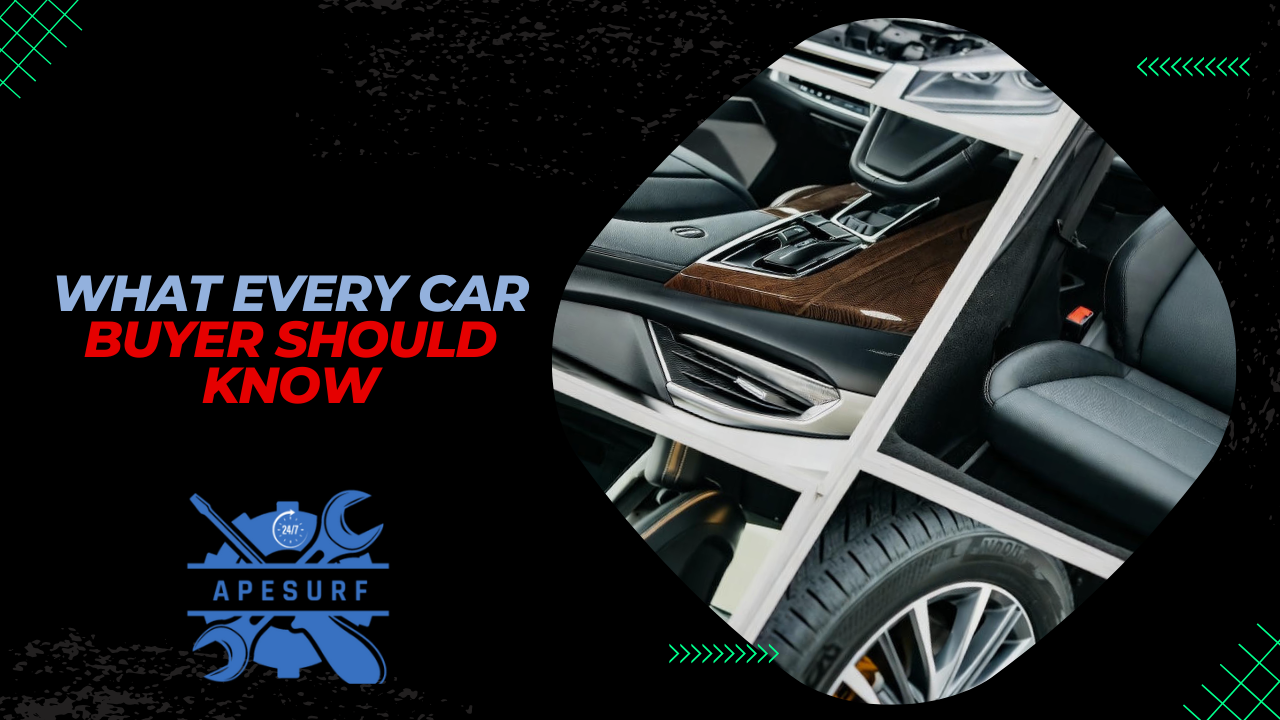
When buying a used car, understanding its history is crucial. One way to do that is by checking its Carfax report, which provides valuable information about the vehicle’s past. Among the many terms that appear in a Carfax report, “functional damage” is one that requires a closer look. This article will explain what functional damage means, its importance, benefits, and provide you with a detailed guide on how to interpret it.
What is Functional Damage?
Functional damage refers to issues affecting the operational aspects of a vehicle. This includes problems that can impact the vehicle’s ability to function properly, even if the exterior might appear fine. For example, if a car has been involved in an accident but was repaired without issues, the frame might be intact, but the steering system or transmission might have sustained some level of damage.
In the context of a Carfax report, functional damage is identified through previous incident reports, inspections, and repair records. Understanding this term is essential for potential buyers, as it can significantly influence a vehicle’s safety, performance, and resale value.
HOW TO BUY A CAR | DO NOT DO IT Without Knowing These 5 Things
Why is Functional Damage Important? What Every Car Buyer Should Know !
Understanding functional damage is crucial for several reasons:
Safety Concerns
Functional damage can lead to safety issues. A vehicle may look good on the outside but may have critical components that don’t function as intended. For example, if the brakes are compromised, it poses a serious safety risk. By identifying such issues ahead of time, buyers can make informed decisions about whether to proceed with a purchase.
Resale Value
A vehicle with documented functional damage may lose significant resale value. Car dealerships and private buyers often check a Carfax report before making an offer. If functional damage is revealed, it can deter them from buying or significantly lower the offer price.
Informed Decision-Making
When you understand functional damage, you can make more informed choices. It empowers you not only to negotiate better prices but also to seek out additional inspections or repairs before finalizing the purchase.
Benefits of Understanding Functional Damage
Understanding functional damage offers several benefits for both car buyers and sellers. Here’s how:
Informed Choices
Being aware of potential functional issues allows you to make choices backed by information. You can decide whether to invest in repairs or walk away from a vehicle that might lead to future liabilities.
Negotiation Power
Knowledge is power when it comes to negotiation. If you identify functional damage, you can use it to negotiate a lower price. This puts you in a beneficial position during the purchasing process.
Peace of Mind
Knowing the functional history of a vehicle provides peace of mind. By selecting a vehicle that does not have unresolved functional issues, you can drive with confidence, knowing that your safety and that of your loved ones is a priority.
How Functional Damage is Reported on Carfax: Step by Step Guide
Understanding how Carfax reports functional damage is essential. Here’s a step-by-step guide on decoding this information.
Step 1: Obtain the Carfax Report
To evaluate functional damage, start by getting a Carfax report. You can usually obtain one from various online platforms, car dealerships, or directly from Carfax.
Step 2: Understand the Report Sections
Upon opening the report, look through various sections. You’ll find tabs regarding the vehicle’s history, including accidents, title status, service records, and any noted functional damage.
Step 3: Look for Incident Reports
Check under the “Accidents” or “Damage” sections. Carfax highlights incidents where damage occurred and includes details on whether that damage was deemed functional or cosmetic.
Step 4: Analyze Repair Details
If functional damage is reported, delve deeper. The report should detail what repairs were made and whether the issues were resolved, repaired, or left unresolved.
Step 5: Consult a Mechanic
If the report indicates functional damage, consult a qualified mechanic for a further inspection. They may uncover additional issues that might not be documented in the Carfax report.
Step 6: Decide
Based on the report and the mechanic’s evaluation, make an informed decision. If the functional damage is severe and unresolved, it might be best to reconsider the purchase.
12 Things To Check Before Buying A Used Car
Tips for Dealing with Functional Damage
Knowing how to handle functional damage properly can save you from potential headaches in the future. Here are some tips to keep in mind:
Research Before Buying
Before purchasing a car, always conduct thorough research. Look for reviews on the make and model, focusing on known issues. This enables you to have a comprehensive understanding before digging into functional damage.
Don’t Ignore the Details
Pay close attention to details about reported functional damage. Look for specific repairs done, the extent of the damage, and whether there are warranties or guarantees on the repairs.
Use the Right Terminology
When negotiating or discussing functional damage, use clear terminology. Instead of merely saying “it’s damaged,” specify the affected components this communicates your understanding and can boost your negotiating position.
Consider a Second Opinion
If you’re uncertain about the Carfax report’s findings, seek a second opinion from another qualified mechanic or an inspection service.
Common Mistakes Related to Functional Damage
Understanding functional damage doesn’t come without pitfalls. Below are some common mistakes to avoid:
Ignoring the Report
One of the biggest mistakes is purchasing a vehicle without reviewing its Carfax report. Failing to check for functional damage may lead to unexpected repairs and costs down the line.
Relying Solely on Visual Inspection
Just because a car looks good doesn’t mean it doesn’t have functional issues. A visual inspection can’t replace the detailed information provided in a Carfax report.
Underestimating Repair Costs
Buyers often underestimate the costs to fix functional damage. Consider getting a detailed quote from a mechanic to avoid surprises later.
Jumping to Conclusions
Avoid jumping to conclusions based solely on one component of the report. Functional damage might require a deeper understanding of the vehicle’s overall condition and issues.
FAQs About Functional Damage on Carfax
What types of issues are categorized as functional damage?
Functional damage can include issues such as problems with the engine, transmission, brakes, and electrical systems. These are serious matters that can affect the vehicle’s overall performance.
Does functional damage always affect a vehicle’s safety?
Not always, but it can lead to safety issues if left unaddressed. For example, if brakes aren’t functioning correctly, this becomes a pressing safety concern for the driver and others on the road.
Should I buy a car with functional damage?
It depends on the extent of the damage and whether repairs have been made. Always consult a mechanic before finalizing your decision.
Can I negotiate if there’s functional damage indicated on Carfax?
Absolutely! Functional damage can be a strong negotiating point. Use it to advocate for a lower purchase price or request that repairs be made before purchase.
Is it possible for functional damage to affect my insurance?
Yes, functional damage can impact your insurance premiums. Reporting a vehicle’s functional issues may categorize it as higher risk, potentially increasing your insurance costs.
Conclusion
Understanding what functional damage means in a Carfax report is vital for anyone looking to purchase a used vehicle. By knowing how to identify and interpret functional damage, buyers can make informed decisions that affect their safety, financial investment, and overall vehicle ownership experience. Remember to always delve deeper into the history of the car you’re interested in and seek professional opinions when necessary. By approaching this crucial aspect of car buying with diligence and expertise, you’re setting yourself up for success while navigating the used car market.
Tags :used cars for sale, buy here pay here, used car sales, certified pre-owned cars, used car dealership near me, carfax report, free carfax, used car history check, accident free used cars, one owner used cars, used car financing, bad credit car loans, auto loan calculator, used suv for sale, used trucks for sale, pre-owned vehicles, vehicle history report, car accident history, used car inspection, affordable used cars, used luxury cars, certified used cars, used car buying guide, carfax functional damage, used car safety check, vehicle maintenance history, used car value, trade in used car, low mileage used cars, reliable used cars
Vehicle Maintenance
Essential Tips for Maintaining Your Car’s A/C System
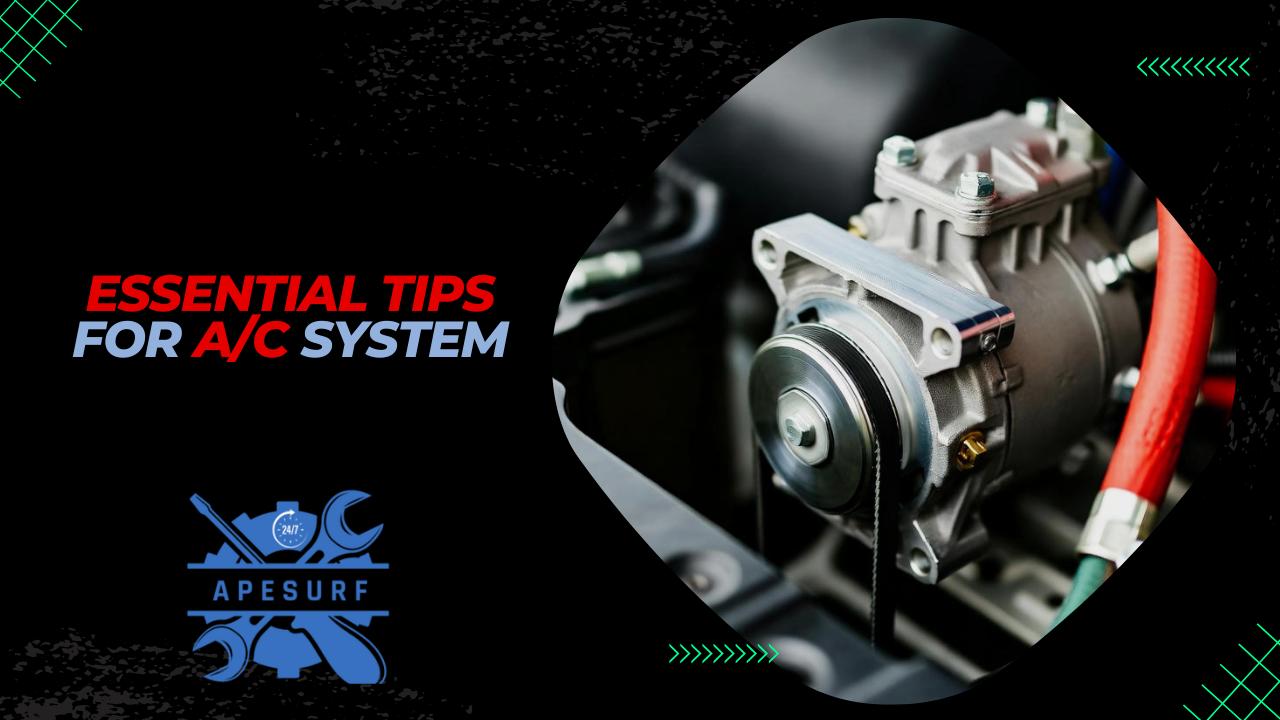
Car air conditioning systems are essential for comfort, especially during hot summer months. Understanding how to maintain this vital component of your vehicle can help prolong its lifespan, improve your driving experience, and save you money over time.
In this article, we’ll explore the definition of a car’s air conditioning system, its importance, benefits, step-by-step maintenance guide, common mistakes, essential tips, and answer frequently asked questions.
What is a Car Air Conditioning System?
At its core, a car’s air conditioning (A/C) system is designed to regulate the temperature and humidity inside your vehicle. It works by cooling the air, removing moisture, and circulating the conditioned air throughout the cabin.
Essential Tips for Maintaining Your Car’s A/C System Car Air Conditioner – How Does It Work? (3D Animation)
Components of the A/C System
The major components include:
Compressor: Often referred to as the heart of the A/C system, it compresses refrigerant and circulates it through the system.
Condenser: This cools the refrigerant from a gas to a liquid by expelling heat.
Evaporator: It absorbs heat from the cabin air, turning the refrigerant back into a gas.
- Expansion Valve: This reduces the pressure of the refrigerant before it enters the evaporator.
- In summary, an A/C system is a complex setup that plays a crucial role in ensuring your driving comfort. Well-maintained, it can effectively cool the cabin climate during sweltering days.
Importance of Maintaining Your Car’s A/C System
Maintaining your car’s air conditioning system is vital for several reasons. Firstly, it ensures optimal performance. A well-functioning A/C system not only keeps you cool but also helps in defogging windows during humid conditions, enhancing visibility and safety.
Secondly, regular maintenance can save you money. Addressing minor issues early can prevent major, costly repairs down the road. For instance, neglected systems may lead to refrigerant leaks or compressor failures, which can be expensive to fix.
Lastly, a properly maintained A/C system promotes better air quality. Over time, dust and pollutants can accumulate in the system, leading to mold or bacteria growth. Regular maintenance helps keep the air inside your vehicle clean and fresh.
Benefits of Keeping Your A/C System in Check
Regular maintenance of your car’s air conditioning system offers numerous benefits. Here are a few:
Improved Comfort
A well-maintained A/C system delivers cool air consistently, helping you stay comfortable during hot weather. It’s particularly important for long drives, where temperature regulation can significantly impact your driving experience.
Enhanced Fuel Efficiency
A faulty A/C system may force your engine to work harder, draining more fuel. By ensuring optimal performance through maintenance, you can improve your vehicle’s fuel efficiency.
Increased Resale Value
If you maintain your car’s associated systems properly including the A/Cyou can boost its resale value. A fully functional A/C is a desirable feature for potential buyers.
Healthier Cabin Air Quality
Regular servicing of the A/C system ensures that allergens and contaminants are filtered out, leading to cleaner air inside your car. This can be particularly important for individuals with allergies or respiratory conditions.
Extended Lifespan of the System
A little preventive care goes a long way. Regular checks can prolong the lifespan of your A/C system, saving you replacements or expensive repairs.
Step-by-Step Guide to Maintaining Your Car’s A/C System
Follow this systematic guide for maintaining your car’s air conditioning system.
Step 1: Regularly Check Refrigerant Levels
Refrigerant is the substance that cools the air in your A/C system. Check the owner’s manual for the appropriate refrigerant type and level. For most cars, a little gauge can help measure pressure if levels are low, you may need a recharge.
Step 2: Replace the Cabin Air Filter
Your cabin air filter prevents dirt, dust, and allergens from entering your car’s interior. Check the owner’s manual for guidance on how often to replace it, but doing so annually is generally a good practice.
Step 3: Inspect and Clean the A/C Components
Regularly check the condenser and evaporator for any signs of wear. Clear any debris or dirt that may have gathered around these components, as they can hinder performance.
Step 4: Test the A/C Functionality
Turn on your car’s A/C system periodically even in winter. This can help circulate the refrigerant and prevent seals from drying out. Ensure that the airflow is consistent and check for any unusual noises.
Step 5: Professional Inspection
Consider scheduling a professional inspection every couple of years. A certified technician can identify issues you may overlook and conduct a thorough cleaning and servicing of the entire system.
Step 6: Monitor for Leaks
If you notice that the A/C isn’t functioning as it should or there is a musty odor, inspect for leaks. Small leaks can often be fixed with sealants, while significant leaks may require system repairs.
Step 7: Run the A/C Regularly
Even during colder months, run your A/C unit to keep the components lubricated and the refrigerant moving through the system. This will help prevent premature wear and maintain functionality.
Tips for Maintaining Your Car’s A/C System
Here are additional recommendations to keep your A/C system working well:
Use A/C When Needed
Running your A/C occasionally helps the system stay in shape. It also prevents the seals from drying out, causing them to crack or leak.
Maintain Proper Ventilation
Open windows periodically to air out the cabin. This can reduce the accumulation of moisture, which leads to mold and unpleasant odors.
Avoid Max A/C Mode
While it might seem effective, using max A/C mode can strain your system. Instead, opt for regular A/C settings to extend its life.
Park Shaded or Use Sunshades
Keeping your vehicle cool while parked can reduce the strain on your A/C system when you start driving. Use window shades or park in the shade when possible.
Keep the A/C System Clean
Contaminants can easily build up in the A/C system. Regularly check and replace cabin air filters to ensure air quality.
Common Mistakes in A/C Maintenance
It’s easy to overlook essential steps in A/C maintenance. Here are some common mistakes to avoid:
Skipping Regular Checks
Neglecting to check refrigerant levels or failing to listen for unusual sounds can lead to bigger issues down the line. A little attention goes a long way.
Ignoring Odors
A musty or moldy smell indicates a problem. Ignoring it can lead to health issues. Take immediate action to identify and resolve the source of the odor.
Waiting Too Long for Repairs
As with many mechanical failures, delaying repairs can worsen the problem. Always address issues as soon as they arise.
Not Using A/C in Winter
Some drivers believe that not using the A/C in winter is better for the system, but running it periodically actually helps maintain seals and lubricate components.
Frequently Asked Questions (FAQs)
How often should I recharge my A/C system?
Recharging your A/C system every one to two years is generally recommended. However, if you notice a decline in cooling efficiency, it’s a good idea to check the refrigerant levels sooner.
How can I tell if my A/C system has a leak?
Common signs include insufficient cooling, strange noises, or visible refrigerant stains around the A/C components.
Is it worth it to have a professional service my A/C system?
Yes, a professional service can identify issues that may be missed by an untrained eye. They can also provide a thorough cleaning and servicing that can prolong the life of your A/C system.
Can I use DIY products to fix A/C issues?
While there are many DIY products available, it’s best to consult a professional for significant repairs or issues. Improper handling or use of the wrong products can cause further damage.
Conclusion
Maintaining your car’s air conditioning system is essential for comfort, fuel efficiency, and overall vehicle performance. By following the steps outlined in this guide, you can easily ensure your A/C system stays in top shape. From checking refrigerant levels to scheduling professional inspections, proactive care is crucial for prolonging the life of your air conditioning system.
Remember that small maintenance tasks can save you time and money in the long run, helping you enjoy a comfortable ride, no matter the weather. With proper care, your A/C will provide cool relief for years to come.
Tags : car maintenance, air conditioning system, vehicle parts, car care tips, refrigerant levels, professional inspections, fuel efficiency, vehicle performance, car comfort, automotive maintenance
-
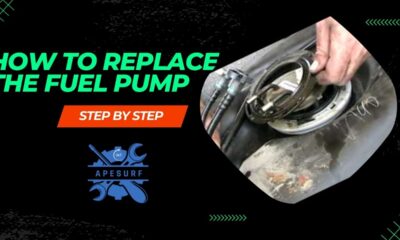
 Vehicle Maintenance1 year ago
Vehicle Maintenance1 year agoHow to Replace the Fuel Pump on a 2000 Silverado: A Step-by-Step Guide
-
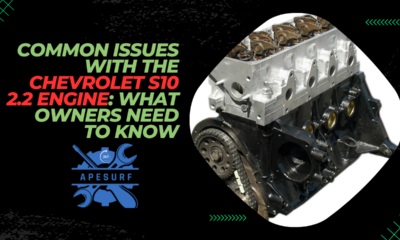
 Vehicle Maintenance1 year ago
Vehicle Maintenance1 year agoCommon Issues with the Chevrolet S10 2.2 Engine: What Owners Need to Know
-

 Vehicle Maintenance1 year ago
Vehicle Maintenance1 year agoIs the BJ’s Wholesale Auto Buying Program Worth It?
-

 Vehicle Maintenance1 year ago
Vehicle Maintenance1 year agoUnderstanding the Hyundai vehicle Lease Early Termination Fee: What You Need to Know
-
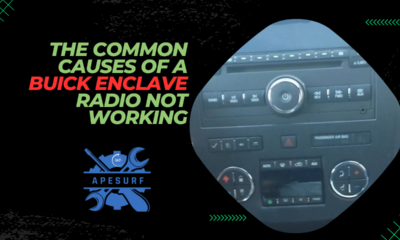
 Vehicle Maintenance1 year ago
Vehicle Maintenance1 year agoThe Common Causes of a Buick Enclave Radio Not Working
-
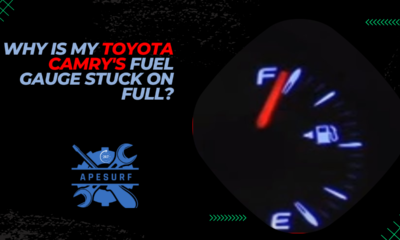
 Vehicle Maintenance1 year ago
Vehicle Maintenance1 year agoWhy is my Toyota Camry’s fuel gauge stuck on full?
-
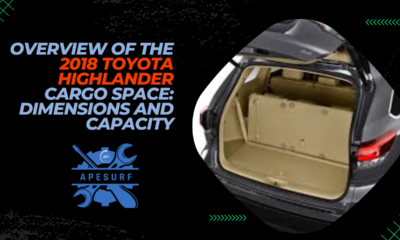
 Vehicle Maintenance1 year ago
Vehicle Maintenance1 year agoOverview of the 2018 Toyota Highlander Cargo Space: Dimensions and Capacity
-
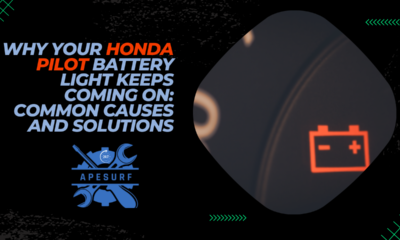
 Vehicle Maintenance1 year ago
Vehicle Maintenance1 year agoWhy Your Honda Pilot Battery Light Keeps Coming On: Common Causes and Solutions






